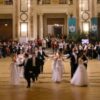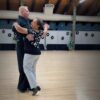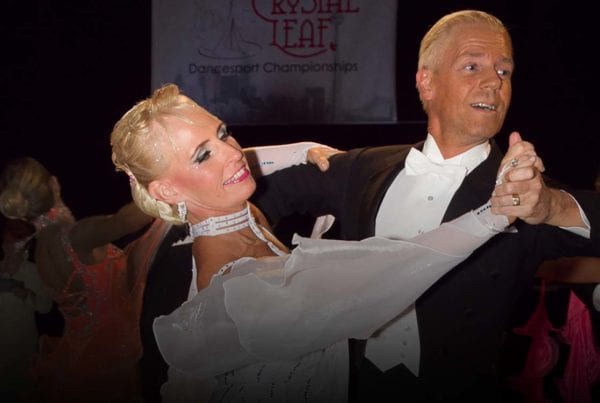Dance is about musical interpretation. This post explores six ways that music can influence your choreography. When you understand these aspects of musicality, you should be able to create more musical dancing.
Swing
The first type of action is a Swing action. Many steps have a swing character for musical purposes. In terms of musicality this doesn’t necessarily refer to the pendulum swing itself. Swing in this case refers only to the musical value through the movement, so it applies to Latin/Rhythm as well as Ballroom/Smooth dances (as do all six of these variations). In such actions, for musical purposes, the primary emphasis is on the center of the movement, at the point of maximum kinetic energy. A good example is the Natural Turn in Waltz. At the end of the first step we reach the center of the pendulum swing, which is the moment of greatest kinetic movement. After that the momentum begin to slow as it continues to rise until it reaches its peak. The musical emphasis is somewhere around the center point. If you’re confused by Swing musicality as a Latin element, just think of the Whisk in Samba.

Impulse
In an Impulse action, the energy takes place at the beginning of a step. Think of what happens when fireworks go off. There is a moment of great energy, after which it dissipates and releases more gradually. Impulse can be used in many places in Tango, even a basic Closed Promenade.

Impact
Impact actions happen when the emphasis is placed at the end of the movement. If you move and run into a wall there’s a very sudden stopping action. It is an impact. A Contra Check, especially in a dance with staccato action such as Tango, is a perfect example of an Impact musical emphasis. There is motion and then it very suddenly stops to create a dramatic effect. The same thing happens in the checking action of a Cross Basic in Cha Cha. It’s important to note that this doesn’t mean everything comes to a full stop. It simply means that the primary emphasis is at the end of the step. There should always be some continual movement even after that point. You don’t want to stop like a wall and throw away the energy, but instead keep flowing to create energy for the next action.

Sustained
In a Sustained action, the motion continues fairly steadily throughout the sequence of steps. Think of a series of steps that do not create a strong sense of any one being more important than any other. In such cases we can say that the dance has a Sustained quality. A sustained action is often a sequence of steps that have similar importance. For example, a Chasse in most dances can be thought of as sustained for musical interpretation.

Percussive
A Percussive action involves a very definite beat pattern that repeats fairly quickly and evenly. Steps that have a prominent action that is repeated over and over. A good example would be a series of Scatter Chasses in Quickstep or the Walks in Jive.

Vibrancy
This happens less frequently than the other types. Vibrancy is similar to Percussive except that it happens so rapidly you can’t identify individual beats in the music. It’s just a rapid pulsing movement. Think of a torso shake during the Spanish Drag in Tango, or a Shoulder Shimmy in Samba.

To make the most of this information, look at each step in your choreography and ask yourself which type of action that step might represent. Write it down. This will form the core of your performance effort. However, as music plays, listen carefully to the character of the music itself. You may find opportunities to apply some of these actions to fit the music or even to contrast what it happening in the music. When you clearly understand what you are trying to present in each part of your choreography, you can improve your dancing significantly.














Hi George,
I read your articles with interest, pleasure and even learned some new things… which I didn’t expect really. My wife and I had a similar dance career to what I read about you. We won Blackpool 4 times and were 8 times Belgian Champion senior latin and 5 times ten dance. That was before 1992, when we became dance teachers and still are.
I teach a music class for Danssport Vlaanderen (the north region of Belgium). In 1965 I obtained a music master and some degree of piano playing. In 1967 I started dancing and never touched a music book or instrument again.
To use a phrase of one of our dance teachers, commenting on this website: “Well done, you !”
Nice to hear from you, Frank! Well done on your part. It’s such a fulfilling and rewarding thing to help others learn to dance.